Vol 1 No. 22 TROPIC LIGHTNING NEWS July 29, 1966
Index
[The 1966 Vietnam issues of Tropic Lightning News were published in Saigon,
and are of lower quality than later years that were printed in Japan. Over
the years the photographs and text have faded and it has been difficult to
reproduce them. Even when the photos are unclear, I have been included
them to give a sense of the activities in the Division.]
3 Units Change Command
Lt. Col. Nicholas At 3/13th Artillery
Lt. Col. Billy B. Nicholas of Little Rock, Ark., assumed command of 3rd Bn.,
13th Arty., last week during ceremonies in the battalion area. He succeeds Lt.
Col. Aaron E. Walker of Allen, Okla., who has become Div. Arty. executive
officer.
Once the battalion colors had been passed, Col. Nicholas, formerly director
of the Division Fire Support Element, spoke to the men.
“On assuming command, I have a feeling of honor, pride and humility,” he
said. “Honor for being selected to lead such a fine unit, pride for becoming a
member of ‘The Clan,’ and humility because I have seen this battalion perform in
an outstanding manner under Col. Walker.”
Col. Nicholas is a 1957 graduate of Eastern Michigan University in Ypsilanti,
where he received a Bachelor of Science degree.
Lt. Col. Holbrook At 2/9th Artillery
Lt. Col. Bruce Holbrook has assumed command of` 2nd Bn., 9th Arty., in recent
change-of-command ceremonies.
The men of the artillery battalion, supporting the 3rd Brigade Task Force,
stood in formation as the outgoing commander, Lt. Col. Saul A. Jackson,
presented the battalion colors to Col. Holbrook.
Col. Jackson had commanded the artillery battalion since August 1965. He is
now assigned to the G-3 section of I Field Force, Vietnam, in Nha Trang.
Col. Holbrook previously worked with the Department of the Army Military
Personnel Management Team, Western Area, at the Presidio of San Francisco.
|
New Commanders |
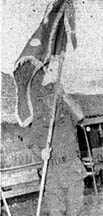 |
Lt. Col. Billy B. Nickolas holds colors of 3/13th Arty. after assuming command of the unit at Cu Chi. (Photo by Williams) |
| Lt. Col. Saul A. Jackson (left), hands the colors of 2nd Bn., 9th Arty., to Lt. Col. Bruce Holbrook at 3rd Bde. (Photo by Sutphin) |
 |
 |
GOLDEN DRAGON CO – Lt. Col. William E. Davis has assumed command of 2nd Bn., 14th Inf., in ceremonies at Cu Chi. Here, his predecessor, Lt. Col. John M. Schultz, and Battalion Sgt. Maj. Jerame J. Szafranski pins on the “Golden Dragon” crest, marking Col. Davis’ assumption of command. The 38-year-old Col. Davis had formerly been division logistics and supply (G-4) officer. Col. Schultz has been assigned to Headquarters, II Field Force, Vietnam. (Photo by Pardue) |
40th Med. Det. Dentists Arrive
A new group of dental workers has been assigned to the 40th Medical
Detachment at Cu Chi in an effort to challenge another enemy – tooth decay.
The detachment has set up shop in two general purpose tent kits, with plans
for a three-quonset clinic on the agenda in the next two months.
The 40th Med. Det. Was activated last February at Fort Hood, Tex., and
participated in the training exercise Operation “Desert Strike” before his
arrival at Vung Tau on May 6.
Commanded by Lt. Col. George Kuttas of Cornwall, N.Y., the 16 officers and 20
enlisted men of the detachment can handle 12 patients at a time in their clinic
at the medical battalion.
They conduct an average of 45 examinations a day and have the capability for
more than 80 regular appointments daily.
Col. Kuttas explained that once the quonsets are built the unit will replace
its field dental gear with permanent, high-speed equipment and will be able to
perform almost every type of dental work available.
With more than $100,000 worth of equipment, the clinic can solve dental
problems ranging from a simple toothache to building prosthetic appliances.
'Tomahawks' Return From
1st Inf. Job
Giant Air Force C-130s took off from Bien Hoa Air Base last week and, five
hours later, had completed air lifting the 4th Bn., 23rd Inf., 40 miles away.
The massive air lift came after the “Tomahawks” had spent more than a month
in the area around Bien Hoa in support of the 1st Inf. Div.
Five C-130s shuttled the battalion, its equipment and support artillery from
7th Bn., 11th Arty., to their new area of operations.
The C-130s, with a capacity of 30,000 pounds, ferried more than 500 people,
100,000 pounds of ammunition, vehicles, rations and fortification materials in
10 sorties. Two sorties were flown by a smaller C-123.
The lift and the two automatic resupply missions were completed in the
morning. Perimeters, command post aid communications were established by
evening, and the Viet Cong were on the run a few hours later.
Viet Cong Mortar Div. Base
The division’s Cu Chi base camp was hit by two Viet Cong mortar attacks
within ten hours of each other on Tuesday and Wednesday.
The first attack began at about 7:22 p.m., Tuesday, and lasted about 90
minutes. The second attack came at 5:03 a.m., Wednesday, and lasted
approximately 35 minutes.
Reports showed that 82mm mortars and 75mm recoilless rifles were fired into
the base camp.
Division gunships and counter-mortar artillery were firing at VC positions.
within minutes after each attack.
Division Helps 1000th Cong Meet Maker
Division soldiers operating out of the Cu Chi base camp scored their 1000th
Viet Cong killed during a noon-time battle last week.
SFC Robert S. Tucker of Moscow, Pa., weapons squad leader in Company A, 4th
Bn., 23rd Inf., made the kill.
Sgt. Tucker, along with his platoon, was pinned down by heavy Viet Cong
automatic weapons fire during a break for lunch. Co. A was providing security
for an Army, Republic of Vietnam, (ARVN) Regional Force that was building
bunkers and reinforcing security positions around a village northeast of Saigon.
Everything was quiet when Capt. Michael D. Iascco, company commander, stopped
the men for lunch. The first and second platoons settled down to a meal of
C-rations on the outskirts of the village, while the third platoon moved in and
began to eat.
Can openers had just started to cut through C-rations when the firing broke
out. Sgt. Tucker’s platoon was pinned down by heavy fire from the village,
while the remainder of Co. A fought off an attack outside the small hamlet.
In the midst of the 15-minute battle, which was raging in a heavy rainstorm,
Sgt. Tucker yelled, “There go three of them into that hooth.” He opened up with
his M-I6 rifle and later found two bodies near the dwelling.
Meanwhile, artillery was called into the area, catching the VC between heavy
fire from Co. A and exploding 105mm howitzer shells being “walked” into the
village perimeter.
Two more bodies were found when the company moved into the village after the
retreating VC.
Tucker was later informed that his kill was the 1000th recorded by division
elements at Cu Chi.
|
Beat VC! |
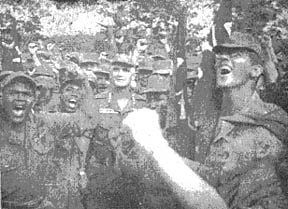 |
| “Wolfhounds!,” called Gen. W. C. Westmoreland, commander, Military Assistance Command, Vietnam, as he finished congratulating men of the 1st Bn., 27th Inf., on their successful operations against the Viet Cong, prompting a loud cheer from the infantrymen. (Photo by Pardue) |
Page 2 TROPIC LIGHTNING NEWS July 29, 1966
Decorated
| BRONZE STAR MEDAL (With 'V' Device) | |
|
PFC James F. Barber, Co. A, 2/14th Inf. 2nd Lt. Thomas P. Byrne, Co. A, 2/14th Inf. 2nd Lt. Dale R. Crafton, Co. B, 2/14th Inf. Sgt. Thomas L. Davis, Co. B, 2/14th Inf. SSgt. Luis Falu-Pesante, Co. B, 2/14th Inf. MSgt. Samuel 0. Holbrook III, Co. B, 2/14th Inf. |
Sgt. James W. Hurst, Co. B, 2/14th Inf. SFC Herbert Maria, Co. B, 2/14th Inf. Sp4 Ronald J. McCullough, Co. A, 2/14th Inf. 2nd Lt. Michael R. Rapuano, Co. B, 2/14th Inf. PFC Charles H. Spinelli, Co. B., 2/14th Inf. |
| AIR MEDAL |
|
|
WO William V. Carroll, D Trp., 3/4 Cav. SSgt. Lance L. Christensen, HHB, 25th Div. Arty. Lt. Col. William E. Davis, HHC, 25th Inf. Div. |
WO John D. Dismer, D Trp., 3/4 Cav. SSgt. James M. Irby, HHC, 1/5th Inf. Maj. Ricardo C. Saria, HHC, 1/27th Inf. |
| ARMY COMMENDATION MEDAL |
|
|
Sp4 Ronald S. Barber, HHC, 1/27th Inf. SSgt. Paul R. Coleman, 25th Admin. Co. Sp5 Raymond Y. Kozuma, HHC, 2/27th Inf. Sp5 Grady O. McDade, HHC, 2/27th Inf. SSgt. Edward J. S. Parent, HHC, 2nd Bde. |
SFC Alexander Sakl, HQ & Co. A, 725th Maint. Bn. Sp4 Billy R. Skinner, HHC, 2/27th Inf. SFC Walter T. Takemoto, HHC, 125th Sig. Bn. SFC Arthur J. Wahner, HHC, 2nd Bde. Sgt. James J. Welsh. HHC, 4/9th Inf. |
VC Plans Well Laid
It has been said that the Viet Cong soldier probably is told the reason for
everything that he does more frequently and in greater detail than any other
soldier in the world. Almost certainly he is required to explain the reasons
for his actions more than any other soldier. Every proposed action is discussed
from all angles before it is taken - and by everyone concerned except the
targets and the innocent bystanders.
Concerning the bystanders, one Viet Cong commented on the bombing of the U.
S. Embassy. “If a few people get killed from a blast it is a risk of the war .
. . The Front (National Liberation Front) is the benefactor of all the people.”
Captain Lam, a “hard-core” Viet Cong, described what happens after action
against a Vietnamese outpost is recommended, showing the almost incredible
effort to make sure that everyone “gets the word” and performs his assigned
duties.
“After studying the proposal, I report it to the head of the Provincial
Military Affairs Committee. He then studies it from all points of view,
considering especially the political effects, and the relative capabilities of
our forces and those of the RVNAF (Republic of Vietnam Armed Forces). If he
approves of the proposed operation he presents it to the secretary of the
Provincial Committee of the Party. The secretary studies it and if he thinks it
sound he calls a meeting of the whole Party Committee to study, discuss and
perhaps approve the proposal.
“Once the proposal is approved by the Party Committee, the Military Affairs
Committee divides the preliminary tasks among its three staffs.
“The Military Staff sends a reconnaissance unit to study the objective from a
military point of view, and to prepare a sand table mock-up.
“The Political Staff sends a cadre to contact the civilians in the area, to
learn their reaction to the (proposed) attack. It also studies the morale of
the troops to see if they are mentally and emotionally prepared. If they are
not, the political staff must take the necessary measures to prepare them.
“The Rear Services Staff (logistics) finds out if the civilians can furnish
the necessary food and labor, including that needed for removal of the dead and
any booty.
“When all this is done, the Military Affairs Committee holds another
meeting. This will be attended by the leaders of all the units that will be
involved in the attack.
“If the majority of the committee believes that the attack should be made,
they report to another meeting of the Provincial Party Committee, which again
reviews the proposed problem and the solution and perhaps directs some
additional action. The Party Committee will approve the attack only if all
conditions - political, military and logistic - appear favorable.
“After this is accomplished all units begin practicing for the attack, either
on a sand table or an actual stake-and-string replica of the target.
“This practice will take from five days to a month, depending on the
difficulty of the target, until every man knows just what he is supposed to do,
how he is supposed to do it, and when. Every detail of the action will be
planned out, including when and where the main force units will meet the local
force and militia units.
“The militia are always necessary to guide the troops and to provide laborers
to carry supplies, to carry off the booty and our dead, if any. We always try
to carry away all our dead, to give them proper burial, which will comfort their
families and strengthen the morale of the rest.”
Editorial
GI Bill Opens Doors
There’s a new law on the books that provides qualified, present-day
servicemen and veterans with a “golden key” to the future. This particular
“key” unlocks many doors.
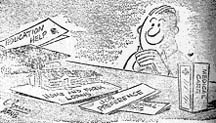 It opens new avenues of educational assistance and medical care, and permits
the purchase of a home or farm.
It opens new avenues of educational assistance and medical care, and permits
the purchase of a home or farm.
It is the same “key” that helped millions of servicemen and veterans of World
War II and the Korean conflict.
Specifically, it is called the Cold War GI Benefits Program, but to the U.S.
Congress, which enacted it into law, it is Public Law 89-458 - the Veterans’
Readjustment Benefits Act of 1966. The Act was signed into law by President
Johnson on March 3, 1966.
Some four million veterans who have served during the past nine years and
nearly three million men and women now on active duty are or will be eligible
for the benefits provided under this Cold War GI Bill, along with 600,000
additional veterans who will be returning to civilian life each year.
Referring to veterans of World War II and Korea (who had similar benefits),
President Johnson said they returned home to find “not just gratitude, but
concrete help in getting a fresh start with educational assistance, with medical
care, with guarantees that permitted them to buy homes to live in.”
In a nutshell the new act expresses the nation’s appreciation for your
service and assures you the opportunity for a higher education if you choose,
and home or farm ownership if you aspire to it. There are also provisions
outlining Federal employment benefits as it concerns veterans as well as
conditions under which medical aid can be obtained through the Veterans
Administration.
So, the golden keys is yours. Whether you take advantage of the Act, either
on active duty or in civilian life, is, of course, your choice. It’s worth
discussing with your personal affairs officer. (AFNB)
New Drug To Attack Malaria
Army medical researchers say a new anti-malaria drug now being authorized for
U.S. troops in Vietnam can cut in half the number of men stricken by the
disease.
Recent field tests conducted here by the Walter Reed Army Institute of
Research (WRAIR) show that DDS (diaminodiphenylsulone), a drug long used in
treating leprosy, will combat a severe form of malaria which has resisted usual
treatment.
Troops will be given one 25 milligram pill each day and will continue to take
the pills for one month after leaving Southeast Asia.
Soldiers receiving the drug who still contract malaria should now be able to
return to duty in two or three weeks, instead of six to eight weeks as before.
Chances of a relapse, according to WRAIR, are expected to be cut from 40 per
cent to four per cent.
In 1965, malaria caused a loss of 63,035 man days from duty in Vietnam.
The Army Malaria Research Program of WRAIR conducted its tests from December
1965 until May 1966. More than 100 university teams, private firms and military
research units have been brought together for the malaria research program at
WRAIR in Washington and in the field. (ANF)
| The TROPIC LIGHTNING NEWS is an
authorized publication of the 25th Infantry Division. It is published
weekly for all division units in the Republic of Vietnam by the
Information Office, 25th Infantry Division, APO U.S. Forces 96225. Army
News Features, Army Photo Features and Armed Forces Press Service material
are used. Views and opinions expressed are not necessarily those of the
Department of the Army. Printed in Saigon, Vietnam, by Saigon Daily
News. Maj. Gen. Fred C. Weyand . . . . Commanding General Maj. William C. Shepard . . . . . . Information Officer 1st Lt. William H. Seely III . . . . Officer-in-Charge Sp5 Dale P. Kemery . . . . . . . . . Editor Sp4 David L. Kleinberg . . . . . . Editorial Assistant |
Page 3 TROPIC LIGHTNING NEWS July 29, 1966
‘DEW’ Line
Tower Assists Bunker Watch
A 50-foot observation tower recently constructed at Cu Chi has become the
division’s “distant early warning line.”
The tower, equipped with telescope and 50-cal. machine gun, was originally,
constructed to assist bunker observation teams in detecting and checking enemy
movement.
Now it is an all-purpose watch tower, poking its nose high above the weeds
and trees which obscure the vision of bunker observers.
Before the tower’s construction, the enemy could have approached within
grenade-throwing range of the perimeter before being detected. Now, with the
use of telescopes, it is almost impossible for anyone to advance within 1,000
feet of the base camp wire.
The tower is also equipped with a radio and three telephones. Upon sighting
the enemy, the observer in the tower alerts the bunker crews, the company
commander, mortar teams and supporting artillery. Appropriate defensive action
is then taken.
The tower also acts as a “guardian angel” for the night patrols that go out
to intercept the Viet Cong. Again with the use of the telescope, the observer
can keep the patrol under constant surveillance.
Thanks to the success of this first tower, a second has been constructed and
more are on the way.
School Re-Opens At So Do
Not long ago the reconnaissance platoon of the 2nd Bn., 27th Inf., was
assigned the task of securing the small hamlet of So Do and assisting the local
forces in setting up an outpost.
Upon reaching its destination, the recon platoon found the hamlet had no
leaders. The villagers said the elected officials had been killed by the Viet
Cong and free elections had been stopped.
SFC William E. Joiner of Columbus, Ga., said the local school mistress told
him the Viet Cong closed the school. She requested assistance in the form of
school supplies.
That was all the recon platoon needed.
They quickly obtained the school supplies from the division’s “Helping Hand”
Operations Center and delivered them to the hamlet.
Since the arrival of the recon platoon, the villagers have elected leaders to
run the hamlet. In appreciation of the platoon’s efforts, the villagers have
named the outpost “Viria” after Sgt. Joiner’s wife.
They are also thinking about changing the name of the hamlet from So Do to So
Do Recon.
Col. Johnson, Col. Kirkbride Tour Cu Chi
Col. Max J. Kirkbride, Army deputy civil affairs officer (J-5), visited the
division base camp recently for a 25-minute briefing on current operations.
Accompanying him was Col. Lynwood M. Johnson, chief, Vietnam division, J-5, and
former commander of 2nd Brigade. The visitors later toured the artillery fire
support element and the tactical operations center.
MOS ‘Freeze’ Hits Cu Chi
Somewhere in the depths of the Pentagon a discussion could be going on about
three men assigned to the 25th Sup. And Trans. Bn.
“We’ve got to classify them under the MOS code,” one man might say, “but we
can’t find an MOS to match the job - especially in a combat zone.”
“How about, ‘temperature control and morale-building specialist’ for a name?”
asked another Pentagon mind, as he tried the Madison Avenue technique of
brainstorming.
“No,” replied another, “I think internal organs coolant supply specialist’ is
the right name.”
But the “problem” never will reach a solution in Washington.
The real answer lies with Sp4 Francis Kempton of Walla Walla, Wash.; Sp4
George Robertson of Dallas; and PFC Raymond Gurule of Albuquerque, N.M. Ask
them what their job is and without patting a dictionary, they all say “ice cream
maker.”
Under the Supervision of SFC Bernardo Benigno of Honolulu, who runs the Class
I storage yard (ration) for the division, the men are the first to be assigned
to the new “Tropic Lightning” Ice Cream Plant.
With three machines going full blast all day long, they manufacture and pack
enough ice cream to supply every division mess hall with the sought-after
dessert twice a week.
“It sure beats the heat of a mess hall kitchen,” said Kempton, a former first
cook, as he dumped a can of shelled black walnuts into the churning mixer.
The spotless plant turns out 360 gallons of chocolate, vanilla, coffee, tutti
frutti or black walnut ice cream daily. Made in 2 1/2-gallon batches, the
freezy skid stuff is packed and stored until issued on Wednesdays and Sundays.
“I never figured on this type of job in Vietnam,” said Roberson, another
former cook, “and I still haven’t figured out how to tell the people back home
about it. They’ll never believe it.” He remarked, shaking his head.
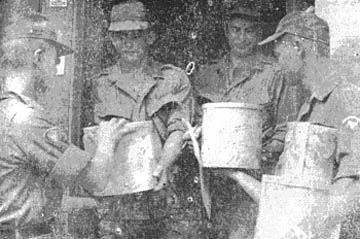 |
WAR IS...SWEET? - PFC Raymond Gurule, (third from left), issues ice cream made in the “Tropic Lightning” Ice Cream Plant to men from 25th Avn. Bn. Taking the cool dessert back to the battalion ration breakdown are Sp4 Jack Nolan (l.) and Sp5 Ronald Rois. Assisting with the distribution is PFC Vernon Swader. (Photo by Pardue) |
Polio No Handicap To Australian Girl
Mary Guy, a 24-year-old Australian from Moonah, Tasmania, is interested in
shellcraft, coin collecting, reading, music and letterwriting.
Only writing a letter is a little more difficult for her than for the average
person.
Miss Guy, a polio paraplegic, who is paralyzed from her neck down, writes
letters by holding a pen between her teeth. She has written letters to members
of the division and would like to write more.
Her first letter to the division came in response to a request by CWO
Franklin H. Brown of Mullins, S.C., and the 725th Maint. Bn. He had written to
a Hawaiian newspaper, and asked that it print a request that letters be sent to
the men of his Unit.
The request was passed by a pen pal to Miss Guy, who promptly responded.
Miss Guy says she enjoys writing and would like to receive letters from
Americans in Vietnam who are anxious to hear from people at home. Postage to
Australia is 15 cents.
In her letter, Miss Guy apologized for not writing as an American citizen to
the soldiers here. Certainly, she needs no apology.
Her full address is Miss Mary Guy, 125 Deswent Park Road, Moonah, Tasmania,
Australia.
Col. J. K. Terry Visits Cu Chi
Col. James K. Terry, of the U.S. Army Combat Development Command, Combined
Arms Group, recently visited Cu Chi to discuss doctrinal matters, coordinate
collection of operational data and visit division maneuver battalions.
After spending 40 minutes with Division Commander Maj. Gen. Fred C. Weyand
and Col. Thomas W. Mellen, division chief of staff, Col. Terry was flown to join
elements of 2nd Bde.
In the field Col. Terry saw combat procedures first hand and was briefed on
the role that the brigade had played since its arrival in Vietnam.
| UP IN SMOKE - Members of Co. A, 1st. Bn., 27th Inf., burn a building while sweeping an area 25 miles southwest of Cu Chi last week. (Photo by Earl) |
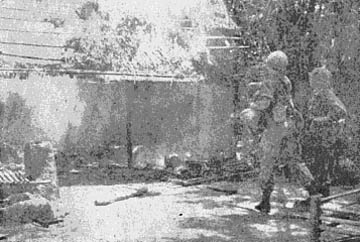 |
Page 4 - 5 TROPIC LIGHTNING NEWS July 29, 1966
A Long Wait in the Long Green Line
 |
| As though they were waiting for the last tickets to the World Series, more than 100 division soldiers line up for the opening of the air-conditioned Cu Chi Post Exchange. The first man in the “Long Green Line” arrived more than two hours before the scheduled 10 a.m. opening. |
Gen. Weyand Says ‘Come In’ -- P.X. Opens
By Sgt. Mike Hirsh
With $50,000 worth of merchandise on the shelves and in storerooms, Division
Commander Major General Fred C. Weyand said, “C’mon in, fellas,” and the Cu Chi
Post Exchange officially opened.
First to enter the air conditioned shoppers’ paradise was SSgt. Donald
Jorgensen of Council Bluffs, Iowa. The soldier from Co. B, 65th Engr. Bn., had
arrived more than two hours before the 10 a. m. opening.
Before the soldiers entered, Gen. Weyand cut the grand opening ribbon. Then
he was taken on a shopping tour guided by Maj. Virgil K. Barnes of Fayetteville,
N.C., the division PX officer.
The first soldier to reach one of the three checkout lines was Sgt. Maj.
Heartsill Wise of Clarksville, Ark., from 125th Sig. Bn.
The more than 100 soldiers outside when the doors opened entered the store in
groups of 20 to prevent crowding.
However, once inside, most of the men made a bee-line for the counter laden
with cameras, radios and jewelry.
Nearly all items available at the main exchange in Saigon can be purchased at
the division PX, including such major appliances as refrigerators and
televisions, as well as toilet articles, food and film.
Although there are no special-order facilities, items not available in the PX
may be mail-ordered from the Japan-Korea Region Pacific Exchange. Catalogs and
order blanks are available at a special counter near the rear of the exchange.
The 400-page division pictorial review book, “The 25th’s 25th... in Combat,” may
also be ordered there.
At present, personal checks are not accepted, although Maj. Barnes said that
eventually a check-cashing facility will be available. Thirty-two enlisted men,
the major and 2nd Lt. Norman Saliman of Denver, Colo., assistant PX officer,
handle the sales. Civilian personnel from the Saigon exchange pitched in to
help with the grand opening.
Although the new facility is resupplied by daily convoy from Saigon, Maj.
Barnes said, “We’ll be doing our best to keep the shelves stocked, but with the
build-up of personnel in the area, many items are still in short supply. For
example, he added, “there isn’t a tape recorder to be had in Vietnam.”
Cu Chi Post Exchange hours are 10 a.m., to 5 p.m. Monday through Saturday,
and 1 p.m. to 4 p.m., Sunday.
|
Photos by Williams and Finklea-Martinez |
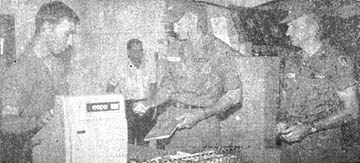 |
FIRST PURCHASE - PFC Oleh Babski of New York City rings up the first sale at the new exchange to Maj. Gen. Fred C. Weyand, division commander. Maj. Virgil Barnes, the division PX officer, looks on. |
| SHOPPING - For the first time since the division arrived in Vietnam, PX shelves are fully stocked. An unidentified soldier does his shopping. |
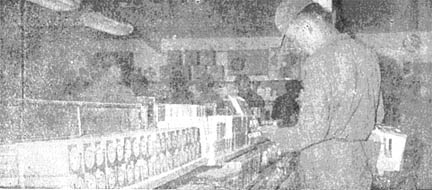 |
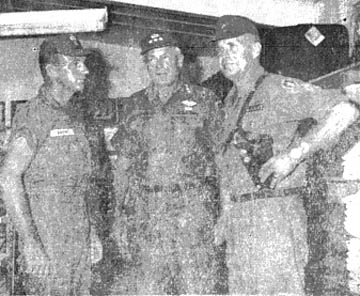 |
PX TALK - Maj. Virgil K. Barnes, division PX officer (left), talks with Lt. John A. Heintges, MACV deputy commander, and Brig. Gen. Edward H. deSaussure Jr., assistant division commander. |
| The display of watches and cameras attracted most of the customers at the official opening. Most cameras were sold out before mid-afternoon. Here, PX clerks check ID and ration cards. |
 |
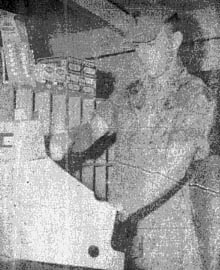 |
CHECK - Second Lt. Norman Saliman of Denver, assistant PX officer, checks one of the cash registers before the official opening. |
Page 6 TROPIC LIGHTNING NEWS July 29, 1966
1/5th Inf. Finds Way To Beat V.C.
In this strange war, it is difficult to find a just way of measuring
success. Counting enemy losses is not always possible, and although a list of
captured supplies is impressive, it in itself does not always reflect the tide
of battle.
The 1st Bn. (Mech.), 5th Inf., however, has found an unorthodox but new way
of measuring success - by proving you don’t have to kill VC to beat them.
In a complex of four hamlets just south of Cu Chi, the 1/5th is conducting an
extensive area pacification program, and meeting with success at every turn.
Classes
Classes on voting, never attended before, are now filled to capacity; more
children than ever are attending school regularly and now hardly a day passes
when someone doesn’t freely offer information on Viet Cong activities in the
area.
How did it happen? What is the secret? It lies in what Capt. Louis Edwards,
the battalion civil affairs officer, calls his Operation “Getting to Know You.”
When pacification began in July, the villagers were cool at best. They
neither knew the Americans, nor why they were there, nor what they would do now
that they had arrived.
Talk
Capt. Edwards had a long talk with the village chief, and then made the first
of many trips through the village. He talked with the farmers about their crops
and livestock; he played with the children, and admired the water buffalo.
He also explained why the Americans had come. He made it clear that they
wanted to help, and said if there was anything the 1/5th could do, he would
appreciate knowing about it.
The battalion medics conducted regular sick calls in the village, and
clothing needed by the people was passed out through the village chief. The
visits to the farmers continued and slowly little bits of information began to
come in. “So many VC had been seen here. So many were known to sleep there.”
Every piece of information was checked but most resulted in little or no
contact. The 1/5th was becoming discouraged.
Word
Then word came from the capital of Gia Dinh Province that two Viet Cong had
turned themselves in to the “Chieu Hoi” (open arms) center. They had come from
the 1/5th’s area and had decided to give themselves up because things were “just
too hot.” The Americans, they said, were everywhere.
A few days later, two more VC, finding the area too hot, gave up. One was
reported to be the Viet Cong’s number one sniper. He brought his rifle with
him.
The longer the Americans stayed, the more secure the villagers felt, and with
security came more and more information. One tip led the Americans on a strike
against a VC tunnel complex. In the attack, the Viet Cong chief of the area and
one of his squad leaders were killed.
VC
On another operation, two VC were captured. One was a 16-year-old propaganda
specialist sent by the Viet Cong from Saigon to try to win back the hamlets they
knew to be slipping from their control.
Capt. Edwards now looks to the future. He has begun English classes for the
children and collected scrap lumber from the division’s 2nd Bde. for the people
to use as fire wood. Soon the medics will begin a series of first-aid classes
for the girls.
Hogs
In addition, the villagers were given 180 hogs by the Vietnamese government.
Capt. Edwards is also investigating the possibility of getting some agricultural
advice on improving the peanut crop.
“These are hard working people,” says Capt. Edwards. “They are not satisfied
with what they have. Every time I talk to one of them the dominant theme is
their desire to improve.
“We have two jobs in this war: to fight and to help. We have to do both to
win,” he concluded.
| ERSATZ VILLAGE - Phao Binh villagers complete thatching another roof in community self-help project. Several months of work have converted a former Viet Cong stronghold into this comfortable and sanitary “American town.” (Photo by Hawkins) |
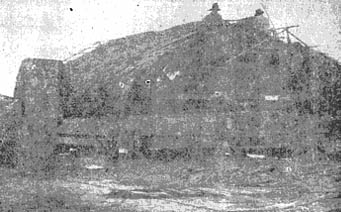 |
Phao Binh
The Perfect Village
To hear Maj. Glen. W. Emery, Div. Arty. civil affairs officer, tell it, the
formula for success in Vietnam is: take some willing villagers and mix well with
U.S. help. And he has the village of Phao Binh to back him.
When Maj. Emery first met the villagers he found them friendly and interested
in improving what they had. The village chief said that he and his people would
“totally support the United States and the Republic of Vietnam.”
The civil affairs officer noted that Phao Binh is different from most in
Vietnam; it is completely independent and self-supporting. Since the
division’s arrival, the villagers have thatched all their homes and set up
recreational programs and local industry.
A self-defense militia has been organized to repel Viet Cong attacks. Under
the guidance of the village chief, three permanent buildings have been built and
plans have been made for two more large structures. Electricity is now
available so the villagers can work at night and also take in the local movie.
The self-help program is flourishing. The village people have dug their own
well, which services more than 1200 people.
Health and sanitation are rated as “outstanding.” Capt. James D. Kimball,
the division’s MEDCAP officer, reports that fly-proof latrine facilities,
showers, sumps and a community kitchen have been constructed. A rodent and
insect-control program is underway while virtually all common diseases have been
eliminated.
Drainage in the area was initially very poor. Village labor forces combined
with division engineers to set up an efficient drainage system.
A division-launched English program was well received by the villagers and
practically the entire population now has command of the language. Adult
education classes are now in effect, in hopes of bringing about further
technological advancements.
The village has its own dispensary with a doctor and a well qualified staff.
The dispensary can be identified by the hong tap tu (red cross flag) flying by
its front door.
Where is Phao Binh village? Who is the village chief? The village is
located within the division’s base camp. It is more often called HQ, 25th Div
Arty. The village chief is Col. Daniel B. Williams. Incidentally, Phao Binh
village translated to English means “artillery village.”
25th Rushes to Aid ARVN
Quick reaction by division elements last week is credited with staving off a
Viet Cong attack on the Popular Forces outpost at Phuoc Hiep, a small village
four miles from Cu Chi.
When a VC company attacked the outpost, the handful of defenders went into
action, immediately calling for artillery and armed helicopters from the
division.
In addition to the requested support, two mechanized platoons of the 3rd Sqdn.
4th Cav., were dispatched to aid the beleaguered outpost.
By the time, they arrived, however, the artillery and gunships had done the
damage. The VC broke contact, dragging with them most of their dead and
wounded.
Two bodies were found by the 3/4 Cav., although the Vietnamese garrison
soldiers reported killing 16. In addition, nearly 30 expended recoilless rifle
rounds were found, along with five unexpended rounds.
An assessment made at the scene by U.S. infantrymen indicated that sandbag
fortifications donated by the Division Civil Affairs Office may have saved Phuoc
Hiep from being overrun.
Popular Forces casualties were light.
Wolfhounds Boast Top Recon Platoon
A reconnaissance platoon is essential to any infantry unit, but a good one
can often be the unit’s very backbone.
The reconnaissance platoon of the 1st Bn., 27th Inf., part of Hq. & Hq. Co.,
is the security unit for the tactical operations center during field problems.
A reactionary force for nine nightly ambushes in the field, the platoon also
conducts regular base perimeter sweeps.
During an operation last week, the “recons” were credited with killing two of
the 14 Viet Cong hunted down by the “Wolfhounds,” capturing three others.
In past operations, the platoon has continually lived up to its traditions by
staging effective ambushes, supporting other units and supplying road security.
One of the unique aspects of the “Wolfhound Recons” is their “armored fleet,”
which has proved highly effective on mobile operations.
PSgt. Bobby L. Sturgeon of Connersville, Ind., said the vehicles were armored
in the staging area upon arrival to Vietnam.
“They are highly effective against sniper fire, especially on road security,”
he added.
ARMS Found In Ho Bo Woods
Mechanized infantrymen on reconnaissance missions west of the Ho Bo Woods
recently uncovered large quantities of enemy arms and ammunition.
It was in the same area where outnumbered “Tropic Lighting” infantrymen were
hit last week during a five-hour battle with a Viet Cong main force company,
resulting initially in 51 enemy dead. The latest action uncovered four more
bodies, bringing the total to 55.
A search of tunnels and bunkers in the area netted three 105 rounds, 11 155mm
rounds, eight hand grenades, 18 rifle grenades, 27 anti-tank mines, 22 butterfly
bombs, three Claymore mines, three 81mm mortar rounds and two 250-pound bombs.
Also captured were 11 rifles, 5000 rounds of arms ammunition, miscellaneous
web gear, uniforms and several documents.
Page 7 TROPIC LIGHTNING NEWS July 29, 1966
‘USARPAC Rats’ Hit As Cu Chi Big Cheese
Despite heavy rains and muddy roads at Cu Chi, division soldiers made it to
the USO Show at the Division’s “Lightning Bowl.”
Entertaining the troops were five USO-sponsored Army Entertainment Contest
finalists. Calling themselves the USARPAC Rats, all are stationed at various
military installations in the Pacific.
The show began with a musical introduction by the division band, playing a
medley of tunes ranging from the big band era to the present. Then Sp5 Steve
Black of the 319th Mil. Intel. Bn. in Hawaii stepped on stage and introduced the
other members of the group and the show was on.
Cheers and laughter were the order of the day in spite of wet sand bag seats,
dark clouds and rain.
The men listened to jazz, folk and pop tunes. They laughed at 1st Lt. Warren
Chaney’s ventriloquism act and hummed along with the band. Lt. Chaney is
stationed in Okinawa.
At the end of the performance, the group’s lead singer, Sp4 Wiley Bennet, who
came from Korea, said, “It was great watching all those guys sitting in the rain
to see us perform.”
Lt. Chaney, commenting on the “Lightning Bowl,” said, “This is the best stage
we’ve had in Vietnam so far.”
The piano player, Sp 5 Dave Groter, whose duty station is in Japan, noted,
“The 25th Inf. Div. Band really has some fine musicians. I think the guys would
have come out in this rain just to hear them play.”
More Troops To Vietnam
Defense Secretary Robert S. McNamara has said he anticipates more men will be
needed to bolster air and ground strength in Vietnam. He set current Vietnam
strength levels in round figures at 280,000.
Page 8 TROPIC LIGHTNING NEWS July 29, 1966
Col. Bundy Leaves Div. Chemical Post
Lt. Col. Robert E. Bundy of Pittsburgh, division chemical officer and
assistant operations officer, will leave Monday to fill a joint staff assignment
for the Military Assistance Command, Vietnam, in Saigon.
Col. Bundy, who has served with the division since August 1953, entered the
Army in 1942. The following year, after being graduated from officer candidate
school, he served in four campaigns in Europe.
He returned to active duty in 1948 and served as an armored platoon leader at
Fort Lee, Va.
He served in four more campaigns with a 4.2 mortar company during the Korean
War receiving the Bronze Star Medal, the Army Commendation Medal and Purple
Heart.
He returned to the States where he attended the Chemical Advanced Course at
the Chemical School, Fort McClellan, Ala. From there he was sent to Washington,
D.C., as a member of the Army General Staff.
Col. Bundy received his Master’s Degree in business administration from
Syracuse University in 1960.
From 1960 to 1962, he was an instructor of financial management at Fort Lee’s
Management School and then attended the Naval War College before joining the
division in August 1963.
 New Viet LNO Joins Division From III Corps
New Viet LNO Joins Division From III Corps
Col. Huynh Cong Thanh (ARVN) has been assigned to the division as Army,
Republic of Vietnam III Corps liaison officer.
A veteran of the first weeks of fighting at Dien Bien Phu, Col. Thanh comes
to the “Tropic Lightning” assignment from the ARVN I Corps headquarters in Da
Nang, where he was chief of staff.
In addition to commanding the detachment of ARVN interpreters stationed with
the U.S. infantrymen, the colonel serves as liaison between 25th Division and
ARVN III Corps headquarters.
| FIRST HAND - Four congressmen are briefed by Maj. Gen. Fred C, Weyand, division commander, following a tour of the Cu Chi base comp. Representatives John M. Murphy of New York, Thomas C. McGrath of New Jersey, William D. Hathaway of Maine and Gale Schisler of Illinois were accompanied by Maj. Gen. Lawrence S. Lighter, deputy director of the Air Force Legislative Liaison Office. The legislators, all veterans of World War II and Korea, were on a tour of U.S. military installations in Vietnam. (Photo by Pardue) |
 |
CG Decorates Wolfhounds...
Eight members of Co. A, 1st Bn., 27th Inf., were decorated for heroism by
Maj. Gen. Fred C.Weyand, division commander, in ceremonies last week.
The men were lauded for action the day before when their outnumbered company
was hit by an estimated Viet Cong main force company west of the Ho Bo Woods.
Awarded Silver Star Medals with “V” Device were 2nd Lt. Peter H. Schnizer of
Madison, N.J., and Sgt. Eugene M. Brown of Cleveland.
Bronze Star Medals were awarded to 2nd Lt. James W. Holiday of Lansdale, Pa;
Sgt. Gerald D. Fisher of Seymour, Ind.; Sp4 John S. Blue of Carlhige, N.C.; Sp4
Marion Burns of Switzerland, S.C.; PFC Bernard V. Gabler of Lucinda, Pa., and
PFC Paul J. Edwards of Wakefield, Va.
The “Wolfhounds” arrived in their landing zone at about 1230 p.m. and were on
the ground less than five minutes when they received sporadic fire from a wood
line to their front. As the company moved from the landing zone, small arms and
automatic weapons fire hit them from a wood line to their right.
Sgt. Larry Freeman of Pulaski, Va., a Wolfhound squad leader, said the enemy
was about 75 yards from them when they reached cover. Toward the end of the
battle, the distance was reduced to within 15 meters.
Another squad leader, Sgt. Charles E. Fetch of Ash. Grove, Mo., said his men
were pinned down during the heaviest fighting. “Every time someone moved,” he
added, “he got shot at.”
The enemy was reported to have taken heavy losses each time it attacked.
Automatic weapons were manned by crews of threes. According to 2nd Lt. Roy
Williams, a platoon leader, “whenever we knocked off a crew, three more VC would
pop up.”
Sgt. James Brown, a squad leader in the 3rd Platoon, said the Viet Cong were
“well trained and used fire and maneuver-advance tactics.”
Capt. Lowell Mayone of Saugerties, N. Y., company commander, directed his men
from a helicopter above the battlefield and noted seeing many of the enemy
bodies.
After the battle Capt. Mayone reported, “We hit some hard-core VC and
inflicted heavy casualties on them. Unfortunately, we took losses too. If we
had run into them earlier in the day, we would have stayed and finished them
off. But since it was late, we fought as long and hard as possible before
starting evacuation in time to complete it before dark.”
Reactionary platoons were flown in and received heavy fire as soon as they
hit the ground. Helicopters flew overhead spraying the enemy area with intense
machinegun fire. One chopper was shot down, but the crew was evacuated.
The enemy fought with M-79 grenade launchers and machine guns.
Speaking to companions after the battle, one of the men complained of a
headache because of a grazing wound he received above the right ear. A friend
offered him a pill, but he replied, “No thanks, it’s a pleasant pain. It lets
me know I’m still breathing.”
...and Lauds Heroism
The men of Co. A, 1st Bn., 27th Inf., sat silently as eight of their comrades
were decorated. Some, in blood-stained fatigues, stared glassily at their
fingertips. Others listened to the citations being read by the adjutant,
occasionally dabbing at their eyes.
These are the “Wolfhounds” who dropped from UH-1B helicopters into the midst
of an estimated force of one Viet Cong main force company one day earlier. They
had inflicted heavy casualties on the VC, counting 55 bodies. But the VC, too,
had taken their toll.
Maj. Gen. Fred C. Weyand, division commander, presented two Silver Star
Medals and six Bronze Star Medals for heroism to the soldiers, who only 24 hours
earlier had been through one of their hardest-fought battles of the war.
“You’ve been pushed to the wall - and you’ve stood up and been counted,” said
Gen. Weyand. “We often ask ourselves, ‘What are we’ fighting for?’ Well,”
continued the general, “the answer that makes the most sense to me is that we’re
fighting for those fellows who were laughing and fighting and crying with you
yesterday.”
After decorating the eight men, the general said, “In every action there are
men who rise to the heights, who do things that, if they were rational, they
would never do. At each crisis there will be a group of men, who at that moment
in time, will hold this company together.
“We’re fighting,” he concluded, “to see that these fellows did not die in
vain.”
Thanks to:
The 25th Infantry Division Museum for providing the volume of 1966 Tropic
Lightning News,
Ron Leonard, 25th Aviation Battalion for finding and mailing them,
Kirk Ramsey, 2nd Bn., 14th Inf. for creating this page.
This page last modified
12-28-2007
©2007 25th Infantry Division Association. All rights reserved.